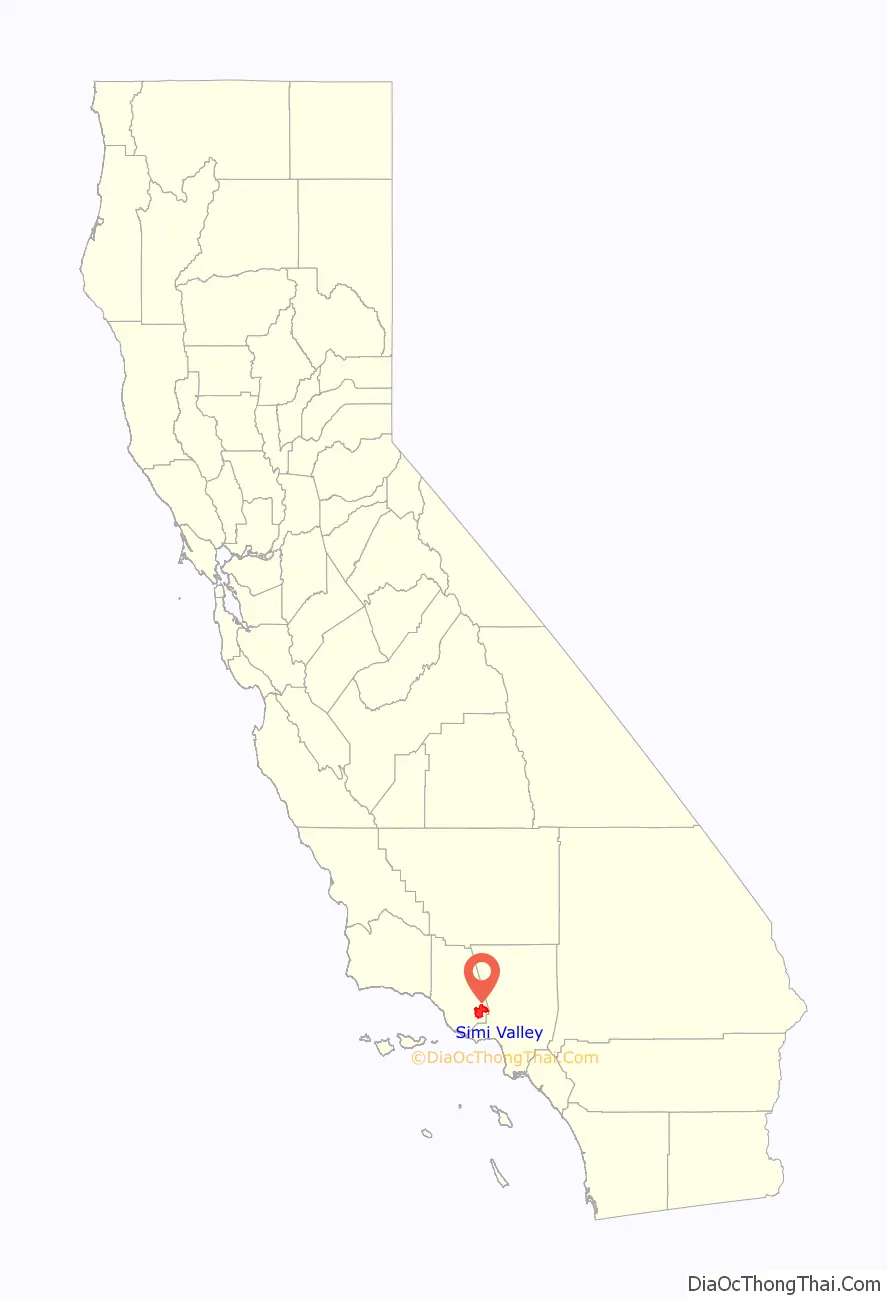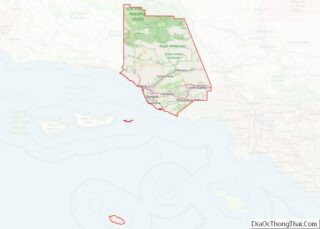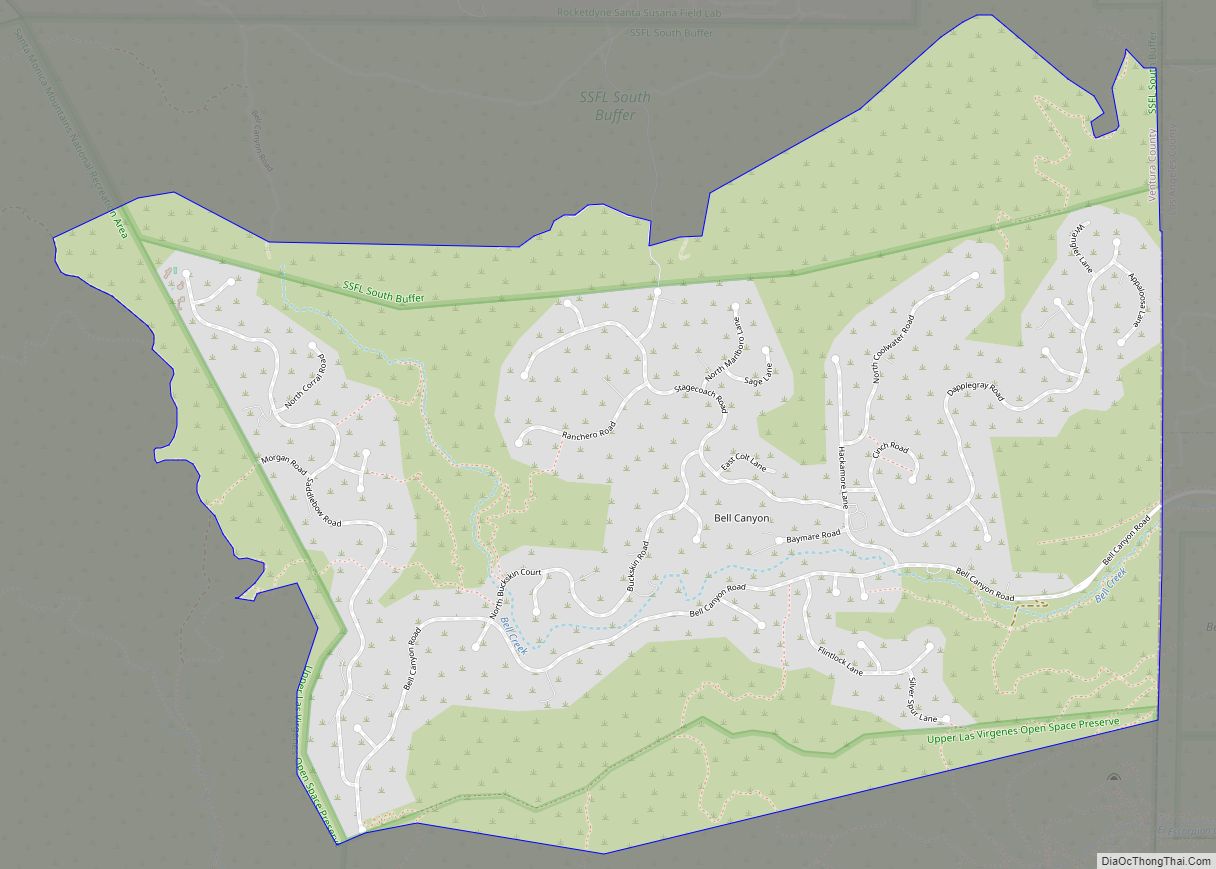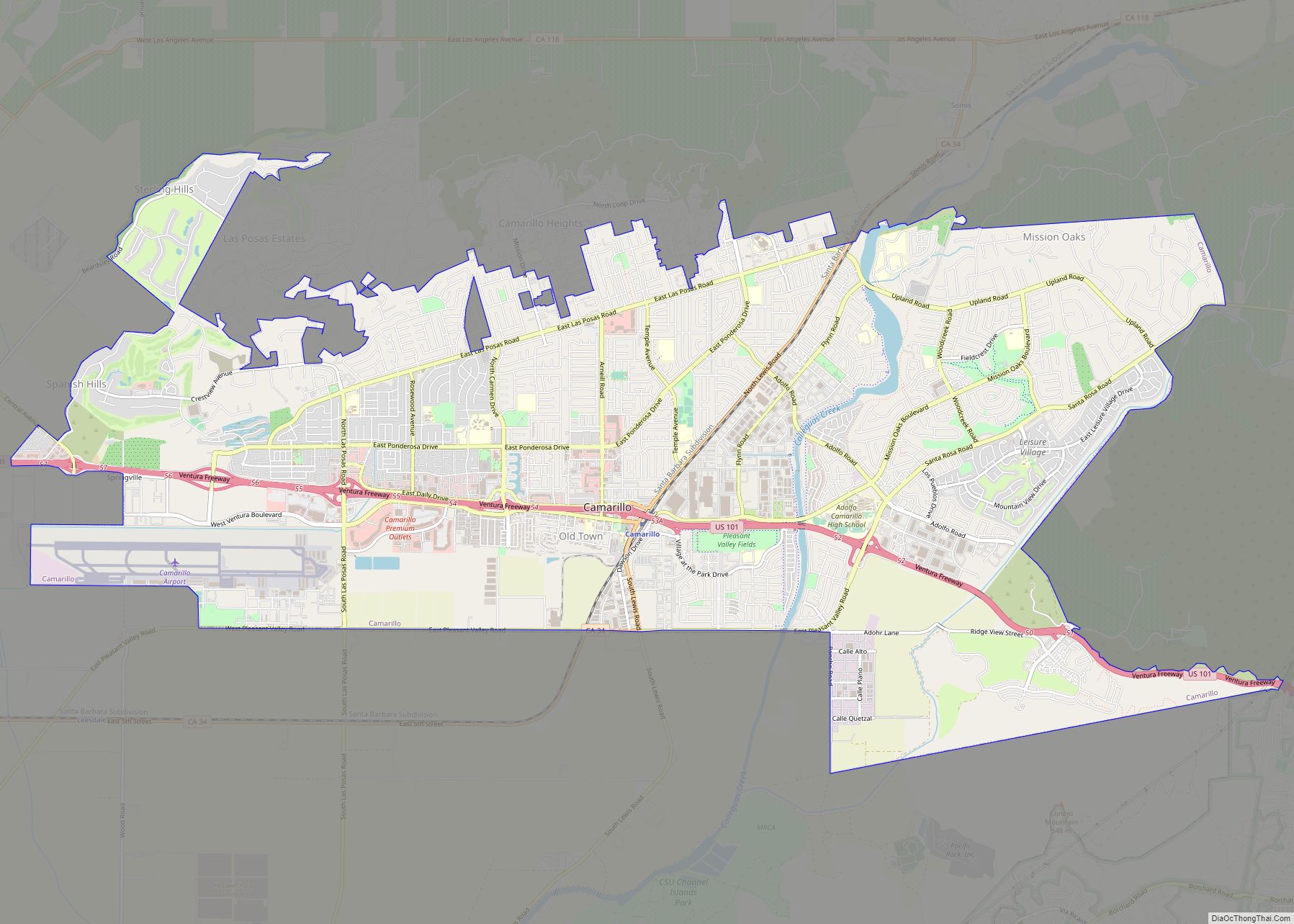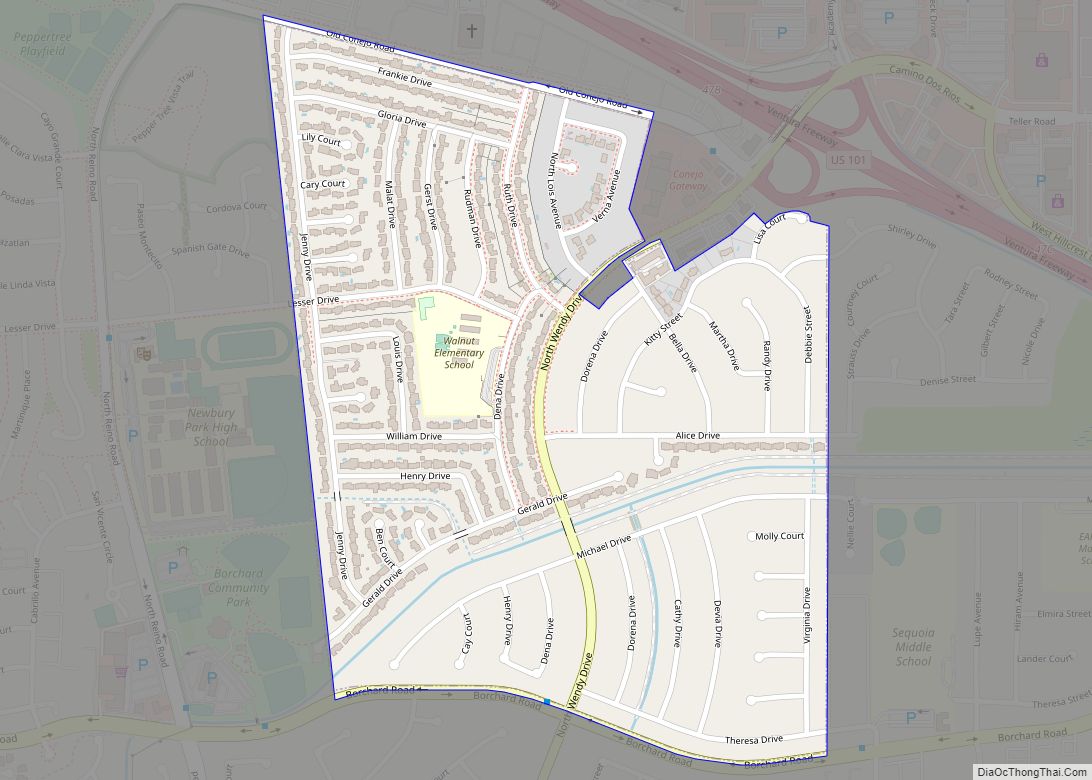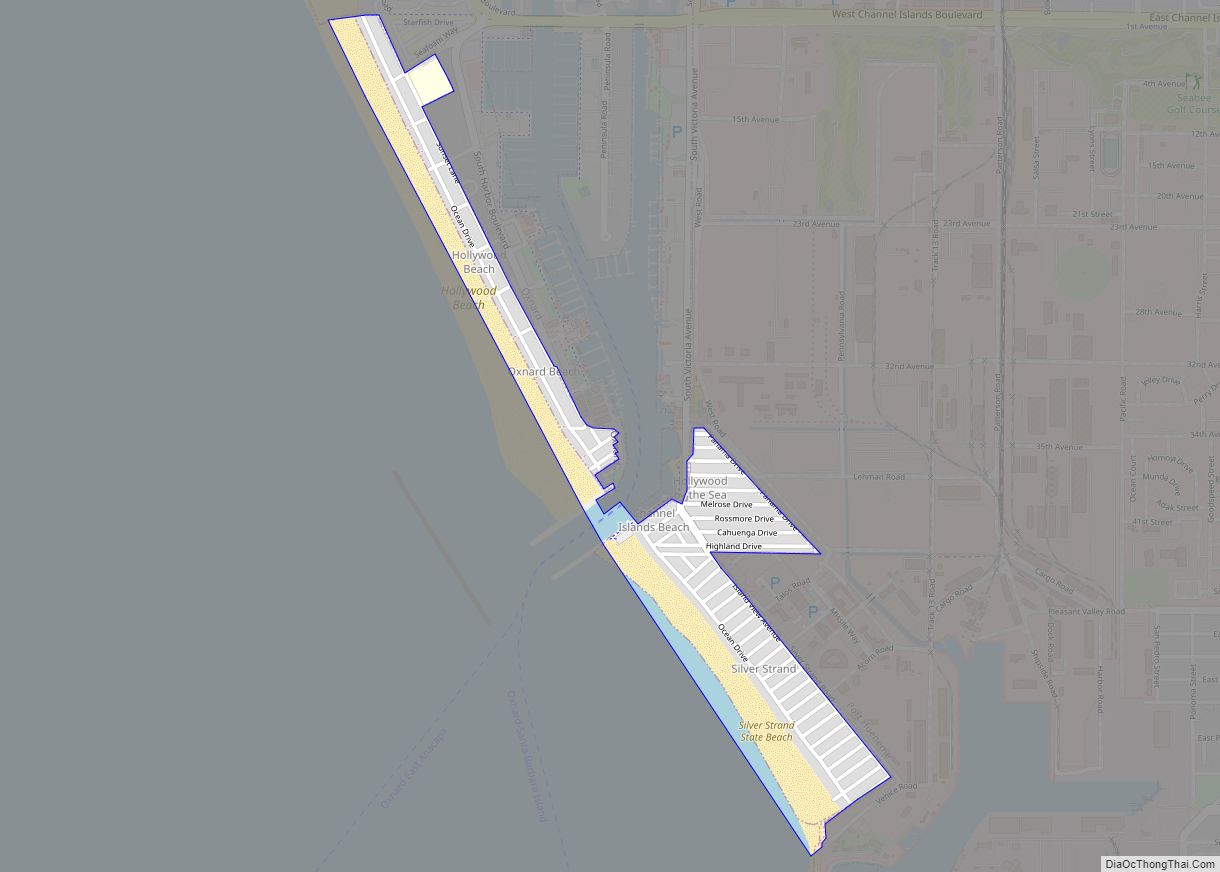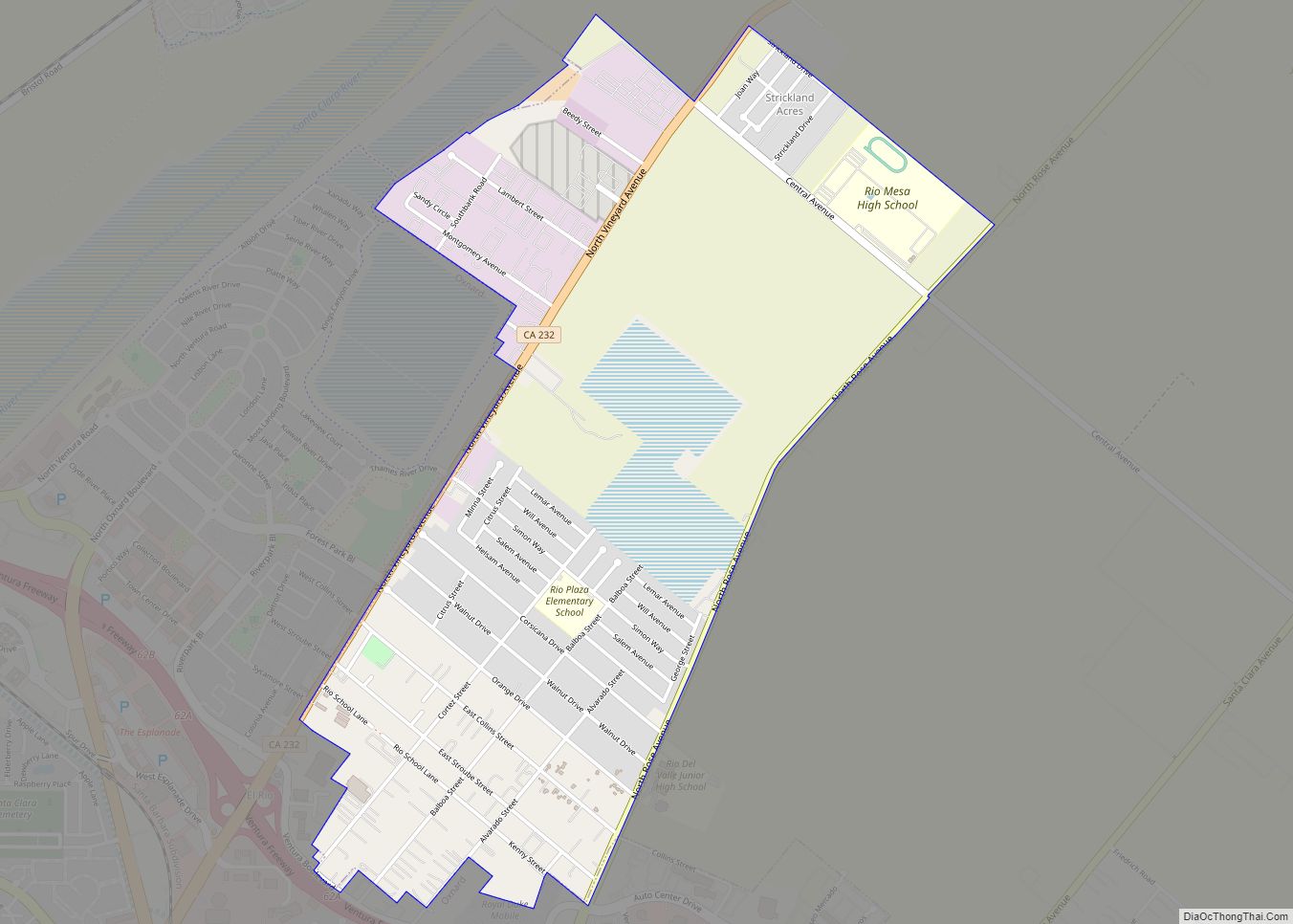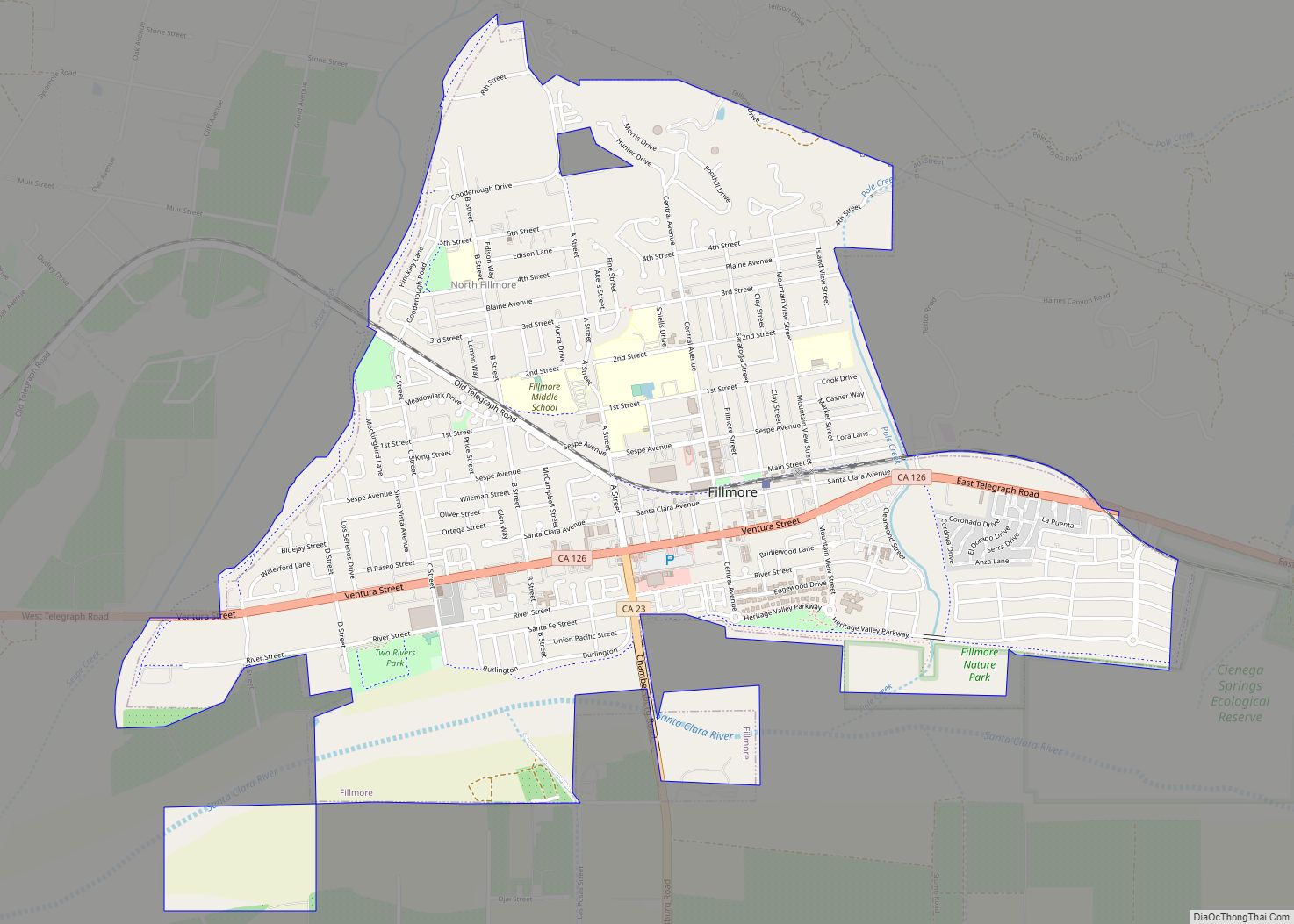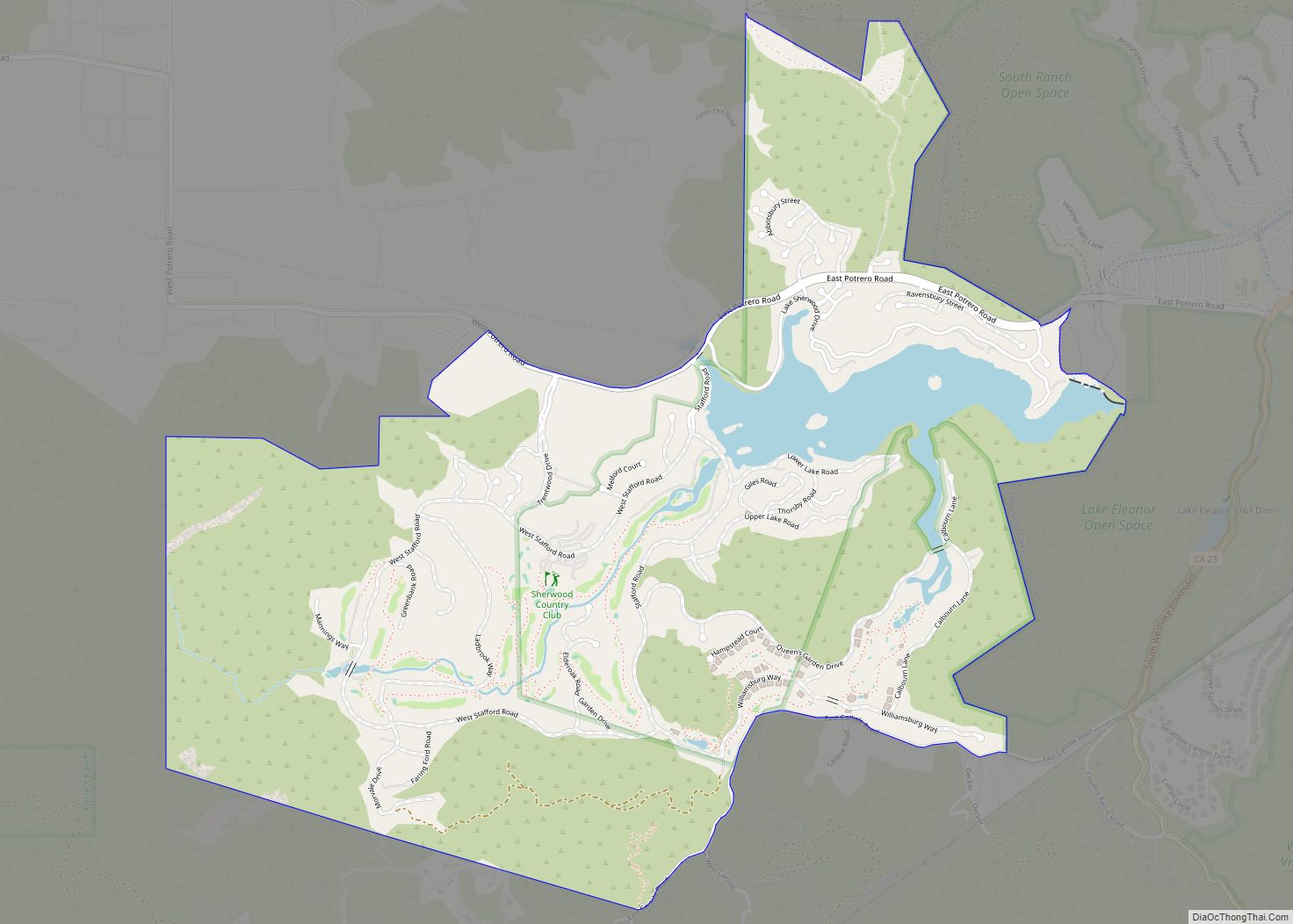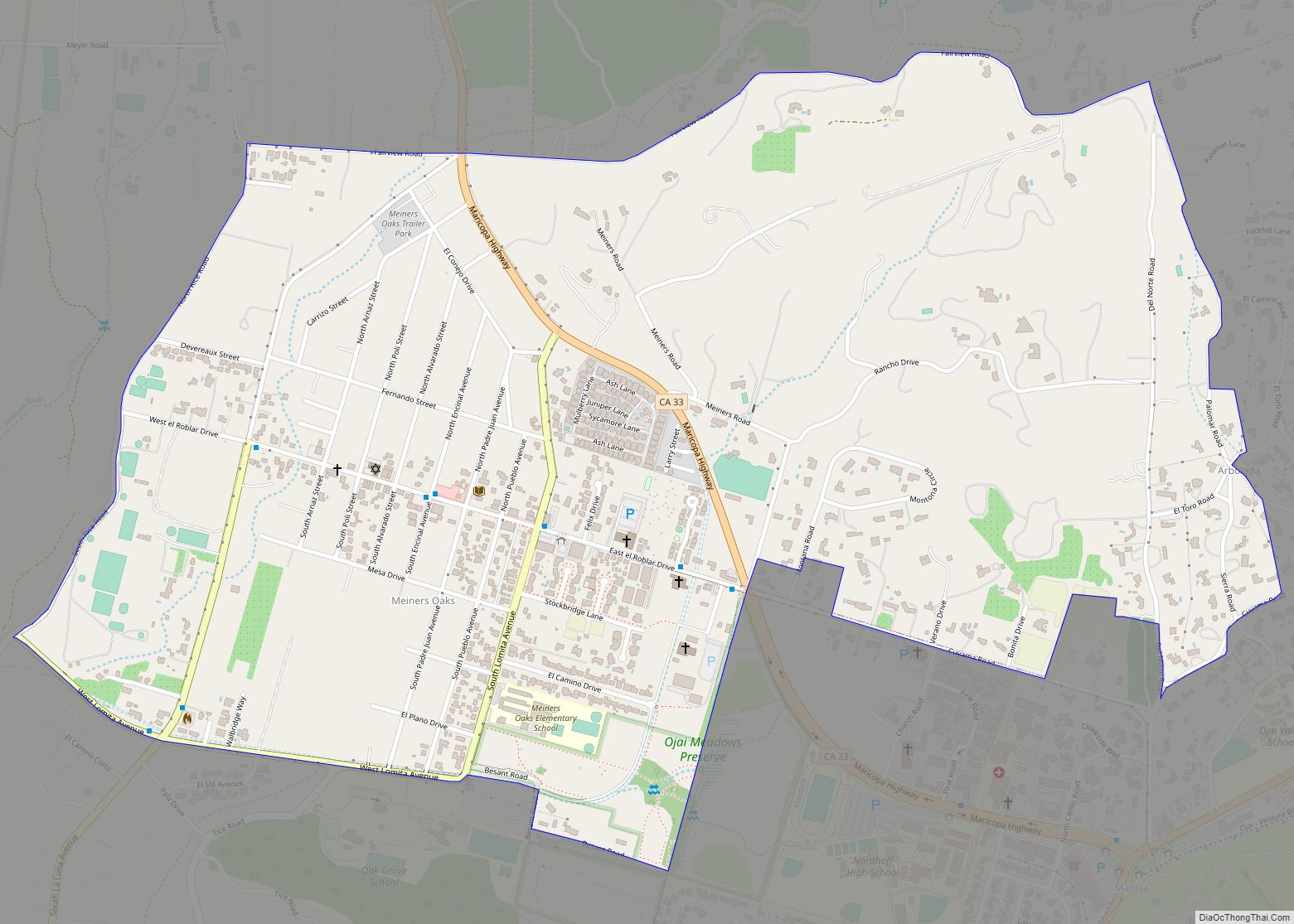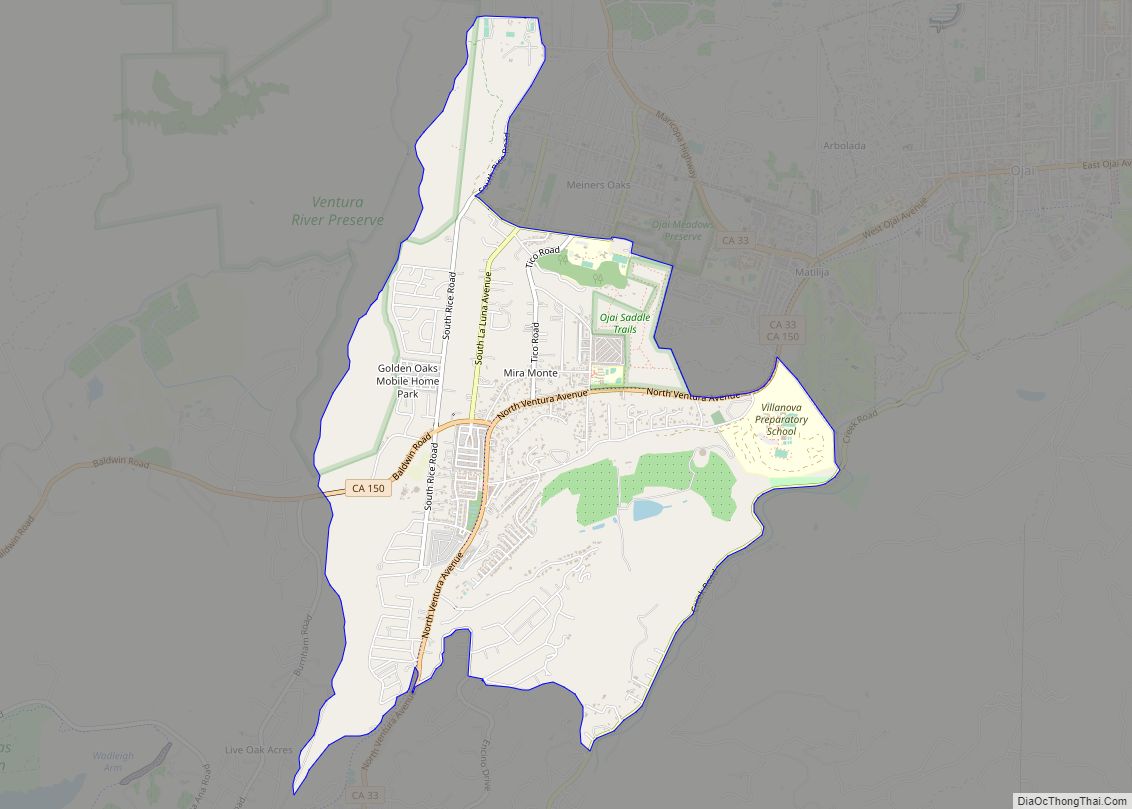Simi Valley (/ˈsiːmiː/ (listen); Chumash: Shimiyi) is a city in the valley of the same name in the southeast region of Ventura County, California, United States. Simi Valley is 40 miles (65 km) from Downtown Los Angeles, making it part of the Greater Los Angeles Area. The city sits next to Thousand Oaks, Moorpark, and Chatsworth. As of the 2020 U.S. Census the population was 126,356, up from 124,243 in 2010. The city of Simi Valley is surrounded by the Santa Susana Mountains and the Simi Hills, west of the San Fernando Valley, and northeast of the Conejo Valley. It grew as a commuter bedroom community for the cities in the Los Angeles area, and the San Fernando Valley when a freeway was built over the Santa Susana Pass.
The Ronald Reagan Presidential Library, where the former president was buried in 2004, is in Simi Valley. The Reagan Library has hosted Republican primary debates in 2012 and 2016.
| Name: | Simi Valley city |
|---|---|
| LSAD Code: | 25 |
| LSAD Description: | city (suffix) |
| State: | California |
| County: | Ventura County |
| Incorporated: | October 10, 1969 |
| Elevation: | 768 ft (234 m) |
| Total Area: | 42.25 sq mi (109.43 km²) |
| Land Area: | 41.54 sq mi (107.60 km²) |
| Water Area: | 0.71 sq mi (1.83 km²) 1.81% |
| Total Population: | 126,356 |
| Population Density: | 3,000/sq mi (1,200/km²) |
| Area code: | 805/820 |
| FIPS code: | 0672016 |
| Website: | www.simivalley.org |
Online Interactive Map
Click on ![]() to view map in "full screen" mode.
to view map in "full screen" mode.
Simi Valley location map. Where is Simi Valley city?
History
Chumash/pre-colonial period
Simi Valley was once inhabited by the Chumash people, who also settled much of the region from the Salinas Valley to the Santa Monica Mountains, with their presence dating back thousands of years. Around 5,000 years ago these tribes began processing acorns, and harvesting local marshland plants. Roughly 2,000 years later, as hunting and fishing techniques improved, the population increased significantly. Shortly after this sharp increase a precious stone money system arose, increasing the viability of the region by offsetting fluctuations in available resources relating to climate changes. The native people who inhabited Simi Valley spoke an interior dialect of the Chumash language, called Ventureño.
Simi Valley’s name is derived from the Chumash word Shimiyi, which refers to the stringy, thread-like clouds that typify the region. The name could have originated from the strands of mist from coastal fog that move into the Oxnard Plain and wind their way up the Calleguas Creek and the Arroyo Las Posas into Simi Valley. The origin of the name was preserved because of the work of the anthropologist John P. Harrington, whose brother, Robert E. Harrington lived in Simi Valley. Robert Harrington later explained the name: “The word Simiji in Indian meant the little white wind clouds so often seen when the wind blows up here and Indians living on the coast, would never venture up here when those wind clouds were in the sky. The word Simiji was constructed by whites to the word Simi. There are other explanations about the name Simi, but this one was given to me by my brother who worked over 40 years for the Smithsonian Institution and it seems most plausible to me”.
Three Chumash settlements existed in Simi Valley during the Mission period in the late 18th and early 19th century: Shimiyi, Ta’apu (present-day Tapo Canyon), and Kimishax or Quimicas (Happy Camp Canyon west of Moorpark College). There are many Chumash cave paintings in the area containing pictographs, including the Burro Flats Painted Cave in the Burro Flats area of the Simi Hills, located between the Simi Valley, West Hills, and Bell Canyon. The cave is located on private land owned by NASA. Other areas containing Chumash Native American pictographs in the Simi Hills are by Lake Manor and Chatsworth.
The Rancho period
The first Europeans to visit Simi Valley were members of the Spanish Portolá expedition (1769–1770), the first European land entry and exploration of the present-day state of California. The expedition traversed the valley on January 13–14, 1770, traveling from Conejo Valley to San Fernando Valley. They camped near a native village in the valley on the 14th.
Rancho Simí, also known as Rancho San José de Nuestra Señora de Altagracia y Simí, was a 113,009-acre (457 km) Spanish land grant in eastern Ventura and western Los Angeles counties granted in 1795 to Santiago Pico. After Santiago Pico’s death in 1815, the Rancho was regranted to Santiago’s sons Javier Pico and his two brothers, Patricio Pico and Miguel Pico, members of the prominent Pico family of California. Rancho Simí was the earliest Spanish colonial land grant within Ventura and Santa Barbara Counties. The name derives from Shimiji, the name of the Chumash Native American village here before the Spanish. It was the largest Spanish or Mexican land grant given in Ventura County, and one of the largest given in California. The Simi Adobe-Strathearn House, later the home of Robert P. Strathearn and family, served as the headquarters of the rancho.
José de la Guerra y Noriega, a Captain of the Santa Barbara Presidio, who had begun to acquire large amounts of land in California to raise cattle, purchased Rancho Simí from the Pico family in 1842. After Jose de la Guerra death in 1858, the sons of Jose de la Guerra continued to operate the ranchos. The end of their prosperity came when several years of drought in the 1860s caused heavy losses. In 1865, the De la Guerras lost the ownership of El Rancho Simí excluding the Rancho Tapo. El Rancho Tapo was part of the original 113,009-acre Rancho Simí grant, but sometime around 1820–1830, the Rancho Tapo came to be thought of as a separate place within Rancho Simí. The last of the De la Guerras to live in Simí Valley retreated to a 14,400-acre portion of the original rancho that was known as the Tapo Rancho. As late as February 1877, Juan De la Guerra was reported in county newspapers to be preparing to plant walnuts in the Tapo, which appears to be the final mention of their farming in relation to the original Simí grant.
The De la Guerra heirs tried every legal means, but by the 1880s, the Rancho Tapo also slipped from their ownership, as had the rest of the Rancho.
The Pioneer period
The Pioneer, or ‘American,’ period in Simi Valley began with the 96,000-acre purchase of El Rancho Simí by an eastern speculator named Thomas A. Scott (1814–1882), who had made his money as an investor in the Pennsylvania Railroad during the Civil War. He was president of the Pennsylvania Railroad, and a partner in Philadelphia and California Petroleum Company. Scouts came to California to purchase lands, and thus Scott acquired El Rancho Simí (1865). His goal was to locate sites for oil, since the first oil well had been developed in Titusville, Pennsylvania just a few years earlier (1859). Within a short time, a 27-year-old man named Thomas Bard was sent west by Scott to manage the California properties. In the late 1880s, Simí Land and Water Company was formed to see to the selling of the huge rancho in ranch-size properties. Some American farmers had begun to lease land in the greater Rancho Simí for farming.
The earliest Anglo American ranchers showed up in Simí Valley in the late 1860s into the 1870s. Charles Emerson Hoar was given the title of “first American farmer” by early Simí historian Janet Scott Cameron. He had purchased the Hummingbird’s Nest Ranch in the northeast corner of the Valley, and he leased land from the new owners of the Simí Rancho for raising sheep, already a proven way of making a living.
Much of the Simí Rancho land continued, as in Spanish days, to be used for raising sheep, cattle and grain. Wheat prospered longer here than in the rest of the county because it was free of a disease called “rust”. Barley soon became the really successful grain crop.
Agriculture and ranching dominated the landscape through the 1950s. Citrus, walnuts and apricots were all grown in Simi Valley. In the early 1960s modern residential development began to take place.
Modern residential development
When Simí was an agricultural community, there were ranch houses that dotted the Valley. Four distinct communities also were located in the Valley (see ‘Four Communities of Simi Valley’ section below) prior to modern residential development. Though 1957 and 1958 brought the first ‘tract’ housing developments when the Dennis and Ayhens, Wright Ranch and Valley Vista tracts were built, the tremendous ‘boom’ in residential development took place beginning in 1960. The population which was 4,073 in 1950 doubled to 8,110 in 1960. By 1970 the population in Simi is reported by the census as 59,832.
Four communities of Simi Valley prior to modern residential development
The pioneers arrived in the late 1860s – 1870s and ever since, this has been ‘The Valley of Simi.’ But, not all the communities in the valley were known as ‘Simi.’ There was the township of Simi (known as ‘Simiopolis’ for about a six-month period in 1888, but then the name reverted to Simi). In the valley there were also the communities of Santa Susana, Community Center and the Susana Knolls (known first as Mortimer Park) at different points in time.
Simi – In the late 1887–1888, the incorporation of Simi Land and Water Company came about. El Rancho Simí was divided into ranches and farms by that corporation, and advertised for sale to midwestern and New England states. An investor group, the California Mutual Benefit Colony of Chicago, purchased land and laid out a townsite (located between First and Fifth Streets and from Los Angeles south to Ventura Ave), named it ‘Simiopolis’ and shipped twelve pre-cut, partially assembled houses from a lumberyard in Chicago via rail to Saticoy, then brought by wagon to Simi. These are known as ‘colony houses.’ This was the first ‘neighborhood’ in Simi. Stores sprung up on Los Angeles Ave, and the first Simi School was built in 1890 on Third and California Streets, and was used until Simi Elementary was built in the mid-1920s.
Santa Susana – In 1903 the Santa Susana Train Depot was built, and the railroad was complete through Simi Valley, except for the tunnel, which was completed in 1904. A small business community grew up near the Santa Susana Train Depot, which was located on the north side of Los Angeles Ave, just east of Tapo Street. Over time residential developments followed and the town of Santa Susana was born. The Depot was moved in 1975 by Rancho Simi Recreation and Park District to its current location off of Kuehner.
Community Center – In 1922 L.F. Roussey laid out the small development which became known as Community Center. The driving force behind this development was the need for a High School in Simi Valley, as well as an elementary school in a more central location in the valley. The FIRST graduating class from the very first Simi High School was 1924, Simi Elementary was completed in 1926, The Methodist Church (which is now the Cultural Arts Center) was built in 1924. Numerous houses were built in Community Center in the 1920s and 1930s. The Simi Valley Woman’s Club was located there as well (the building which served as the clubhouse for the Woman’s Club was moved from the town of Simi). The Woman’s Club club house was used by many individuals and organizations as a community meeting place. It truly was a ‘community center.’
Mortimer Park (the Susana knolls) – The area that is now the Knolls was a nearly 1,800-acre parcel of land that was purchased by Mr. and Mrs. Lewis T. Mortimer in the early 1920s. They planned on selling the lots for cabins, or vacation homes. The lots, however, were very small (30 x 50 feet), and the Mortimers did not take the mountainous nature of the land into account, so quite often the lots were not buildable. Oftentimes several lots were needed to build structures. In 1944 the Garden Club, an active community organization in the area petitioned the county supervisors to change the name of Mortimer Park to the Susana Knolls.
The first attempt to incorporate the towns of Simi, the area known as Community Center (93065) and Santa Susana (93063) in 1966 was unsuccessful. The second attempt in 1969 was successful, with residents voting 6,454 to 3,685 in favor of incorporation. 59% of eligible voters turned out for this vote. Susana Knolls is an unincorporated area of the Valley. Voters also voted whether to call this newly incorporated city ‘Santa Susana’ or ‘Simi Valley.’ The name Simi Valley garnered 2,000 more votes than Santa Susana.
Other items of historical interest
The 2,848 acres (1,153 ha) Santa Susana Field Laboratory located in the Simi Hills, was used for the development of pioneering nuclear reactors and rocket engines beginning in 1948. The site was operated by Atomics International and Rocketdyne (originally both divisions of the North American Aviation company). The Rocketdyne division developed a variety of liquid rocket engines. Rocket engine tests were frequently heard in Simi Valley. The Atomics International division of North American Aviation designed, built and operated the Sodium Reactor Experiment, which in 1957 became the first United States commercial nuclear reactor to supply electricity to a public power system., when it powered the city of Moorpark (the government owned BORAX-III reactor had previously powered Arco, Idaho for around an hour in 1955). The last nuclear reactor operated at SSFL in 1980 and the last rocket engine was produced in 2006. The SSFL has been closed to development and testing. The site is undergoing investigation and removal of the nuclear facilities and cleanup of the soil and groundwater. The Boeing Company, the US DOE, and NASA are responsible for the cleanup.
In July 1959, the Sodium Reactor Experiment suffered a serious incident when 13 of the reactor’s 43 fuel elements partially melted resulting in the controlled release of radioactive gas to the atmosphere. The reactor was repaired and returned to operation in September, 1960. The incident at the Sodium Reactor Experiment has been a source of controversy in the community. Technical analysis of the incident intended to support a lawsuit against the current landowner (The Boeing Company) asserts the incident caused the much greater release of radioactivity than the accident at Three Mile Island. Boeing’s technical response concludes the monitoring conducted at the time of the incident, shows only the allowable amount of radioactive gasses were released, and a Three Mile Island-scale release was not possible. The case was settled, it is reported, with a large payment by Boeing. In September 2009, The U.S. Department of Energy sponsored a public workshop where three nuclear reactor experts shared their independent analysis of the July, 1959 incident.
The Santa Susana Field Laboratory also hosted the Energy Technology Engineering Center. The center performed the design, development and testing of liquid metal reactor components for the United States Department of Energy from 1965 until 1998.
The Santa Susana Field Laboratory includes sites identified as historic by the American Institute of Aeronautics and Astronautics and by the American Nuclear Society. The National Register of Historic Places listed Burro Flats Painted Cave is located within the Santa Susana Field Laboratory, on a portion of the site owned by the U.S. Government. The drawings within the cave have been termed “the best preserved Indian pictograph in Southern California”.
Four officers of the Los Angeles Police Department (Stacey Koon, Laurence Powell, Timothy Wind, and Theodore Briseno) were accused of using unnecessary force in a March 3, 1991 beating of an African-American motorist Rodney Glen King. The case known as the Rodney King Trials was based on footage recorded on home video by a bystander (George Holliday). The now-infamous video was broadcast nationally and globally and caused tremendous response because the beating was believed to be racially motivated. Due to the heavy media coverage of the arrest, Judge Stanley Weisberg of the California Court of Appeals approved a change of venue to neighboring Ventura County, using an available courtroom in Simi Valley for the state case against the officers.
On April 29, 1992, a Ventura County jury acquitted three of the four officers (Koon, Wind, and Briseno) and did not reach a verdict on one (Powell). Many believed that the unexpected outcome was a result of the racial and social make-up of the jury, which included ten white people, one Filipino person, and one Hispanic woman. None were Simi Valley residents. Among the jury were three who had been security guards or in military service. The acquittal led to the 1992 Los Angeles riots and mass protest around the country.
Simi Valley Road Map
Simi Valley city Satellite Map
Geography
Simi Valley is a city located in the very southeast corner of Ventura County, bordering the San Fernando Valley in Los Angeles County, and is a part of the Greater Los Angeles Area. The city of Simi Valley basically consists of the eponymous valley itself. The city of Simi Valley borders the Santa Susana Mountains to the north, the Simi Hills to the east and south, and is adjacent to Thousand Oaks to the southwest and Moorpark to the west. Simi Valley is connected to the nearby San Fernando Valley by the Santa Susana Pass in the extreme east of Simi Valley. Simi Valley is located at 34°16’16” North, 118°44’22” West (34.271078, −118.739428) with an elevation of 700–1,000 ft (210–300 m) above sea level. The syncline Simi Valley is located in the western part of the region called the Transverse Ranges. The valley is surrounded by the Santa Susana Mountains to the north and Simi Hills to the east and south. While the Santa Susana Mountains separate the valley from the Los Padres National Forest in the north, the Simi Hills separate it from Conejo Valley in the south. In the extreme east is Rocky Peak, one of Santa Susana Mountains’ highest peaks, which is a dividing line between Ventura County to the west and Los Angeles County to the east. On the other side of the valley, in the extreme west side of Simi Valley is Mount McCoy, which may be most known for its 12 ft. concrete cross that sits at its peak. The physiographical valley is a structural as well as a topographic depression. The Simi Valley, just as neighboring San Fernando Valley, owes its existence and shape to the faulting and folding of the rocks. It is essentially a structural valley and not wholly the work of erosion. It is drained by the Calleguas Creek and also its principal tributary, Conejo Creek. Both of these originate in the Santa Susana Mountains.
According to the United States Census Bureau, the city has a total area of 42.2 sq mi (109.4 km), comprising 41.5 sq mi (107.4 km) of land and 0.77 sq mi (2.0 km), or 1.81%, of it is water. Simi Valley is located northwest of the Los Angeles neighborhood of Chatsworth and approximately 30 mi (50 km) from Downtown Los Angeles, 380 mi (610 km) south of San Francisco, 160 mi (260 km) north of San Diego, and 350 mi (560 km) south of Sacramento. Commutes to Los Angeles are usually via the Ronald Reagan Freeway (Highway 118) or the Southern California Metrolink commuter train, which makes several daily trips from Simi Valley. Simi Valley has a mediterranean climate. Temperate variations between day and night tend to be relatively big. The mean annual temperature is 64.1 degrees (17.8 °C), while the annual precipitation is 18.39 inches (467 mm). The precipitation remains less than one inch for seven months – April until October, – while the precipitation exceeds four inches in the two wettest months – January and February. While the mean temperature is at its lowest at 53.6 degrees (12.0 °C) in December, the mean temperature in July and August exceeds 76 degrees (24 °C).
Simi Valley has been the victim of several natural disasters, including the flood of 1967, the storm of 1983, the 1988 lightning strike, as well as the 1994 Northridge earthquake and numerous wildfires.
Climate
Simi Valley has a warm and dry climate during summer when mean temperatures tend to be in the 70s. Wildfires do also occur here. The city’s climate cools during winter when mean temperatures tend to be in the 50s. Because of its relatively low elevation, the Simi Hills typically experience rainy, mild winters. Snow is rare in the Simi Hills, even in the highest areas. The warmest month of the year is August with an average maximum temperature of 96 °F (36 °C), while the coldest month of the year is December with an average minimum temperature of 38 °F (3 °C). Temperature variations between night and day tend to be relatively large during summer, with a difference that can reach 38 °F (21 °C), and moderate during winter with an average difference of 29 °F (16 °C). The annual average precipitation in Simi Valley is 17.9 inches. Winter months tend to be wetter than summer months. The wettest month of the year is February with an average rainfall of 4.8 inches. Simi Valley gets 18 inches of rain per year, while the United States average is 37. Snowfall is 0 inches, while the U.S. average is 25 inches of snow per year. The number of days with measurable precipitation is 25. On average, there are 277 sunny days in Simi Valley per year. The July high is approximately 96 °F (36 °C). The January low is 39 °F (4 °C). The record low is 18 degrees Fahrenheit (−8 °C) (recorded in February 1989) and the record high is 116 degrees Fahrenheit (47 °C) (recorded in August 1985). The prevailing wind direction is southwest, and the average wind speed is 7–11 mph (11–18 km/h).
Natural hazards
An aspect of Simi Valley’s location, situated beside the Simi Hills, is that it lies in a high-risk area for the wildfires that sweep through Southern California’s mountain ranges every few years. Simi Valley is also at risk for earthquakes. The valley is surrounded by faults; the closest ones being the Santa Rosa Fault to the Northwest, the Northridge Hills Fault to the Northeast, and the Chatsworth Fault to the South. In 1994, portions of Simi Valley received significant damage from the Northridge earthquake. See Nuclear Accident at SSFL for information on the accident and associated risk(s) to residents.
In autumn 2003, the Simi Fire burned about 108,000 acres. A 2005 fire started on September 28 and burned an estimated 7,000 acres (30 km). On September 29, the fire was estimated to be 17,000 acres (70 km). More than 1,000 firefighters worked against the tricky combination of dry brush, low humidity and temperatures in the high 90s along the line that divides Los Angeles and Ventura counties. The fire was later brought under control and extinguished, without serious injury. Three homes were lost in outlying areas, but none within the city limits.
See also
Map of California State and its subdivision:- Alameda
- Alpine
- Amador
- Butte
- Calaveras
- Colusa
- Contra Costa
- Del Norte
- El Dorado
- Fresno
- Glenn
- Humboldt
- Imperial
- Inyo
- Kern
- Kings
- Lake
- Lassen
- Los Angeles
- Madera
- Marin
- Mariposa
- Mendocino
- Merced
- Modoc
- Mono
- Monterey
- Napa
- Nevada
- Orange
- Placer
- Plumas
- Riverside
- Sacramento
- San Benito
- San Bernardino
- San Diego
- San Francisco
- San Joaquin
- San Luis Obispo
- San Mateo
- Santa Barbara
- Santa Clara
- Santa Cruz
- Shasta
- Sierra
- Siskiyou
- Solano
- Sonoma
- Stanislaus
- Sutter
- Tehama
- Trinity
- Tulare
- Tuolumne
- Ventura
- Yolo
- Yuba
- Alabama
- Alaska
- Arizona
- Arkansas
- California
- Colorado
- Connecticut
- Delaware
- District of Columbia
- Florida
- Georgia
- Hawaii
- Idaho
- Illinois
- Indiana
- Iowa
- Kansas
- Kentucky
- Louisiana
- Maine
- Maryland
- Massachusetts
- Michigan
- Minnesota
- Mississippi
- Missouri
- Montana
- Nebraska
- Nevada
- New Hampshire
- New Jersey
- New Mexico
- New York
- North Carolina
- North Dakota
- Ohio
- Oklahoma
- Oregon
- Pennsylvania
- Rhode Island
- South Carolina
- South Dakota
- Tennessee
- Texas
- Utah
- Vermont
- Virginia
- Washington
- West Virginia
- Wisconsin
- Wyoming

